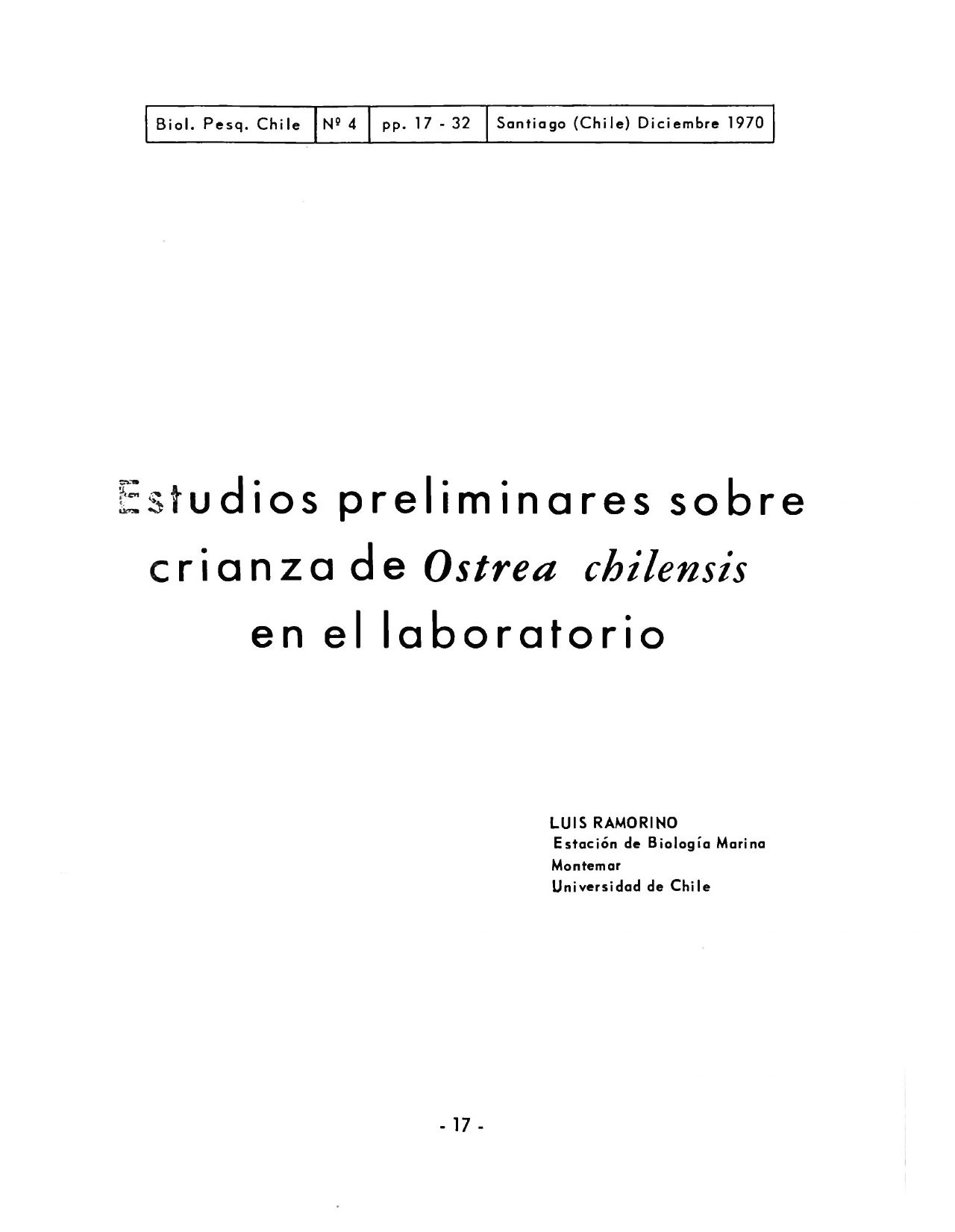Estudios preliminares sobre la crianza de Ostrea chilensis en el laboratorio
DOI:
https://doi.org/10.21703/0067-8767.1970.4.2377Resumen
1.- El propósito del presente trabajo ha sido determinar la posibilidad de obtener larvas de Ostrea chilensis procedentes de Quetalmahue (41º 51' S. - 72º 55' W.) durante los meses de invierno, bajo las mínimas condiciones de laboratorio existentes en Montemar: carencia de agua de mar circulante a temperaturas adecuadas y alimentación poco apropiada a base de Phaeodactylum. Además, experimentar métodos de acondicionamiento y adquirir experiencia en la crianza de la ostra chilena para la planificación de trabajos futuros.
2.- El envío de ostras desde Quetalmahue a Montemar, demoró como mínimo tres días. Se produjo una mortalidad máxima de 76 a 95% en los meses de primavera, y una mínima de un 12% en invierno (cuadro Nº 2). Las ostras prácticamente no sufrieron mortalidad natural durante una permanencia máxima de 7 meses en los acuarios.
3.- No se obtuvo la recuperación de las gónadas en las ostras llegadas en invierno desde su ambiente natural (abril a julio), después de estar sometidas a las condiciones de laboratorio durante un período entre 4 y 7 meses, lo cual se debería a la pobre alimentación basada exclusivamente en Phaeodactylum. La temperatura en el laboratorio fue solamente 1 a 2,5º C. superior a la del ambiente. Las condiciones de laboratorio sólo permitieron la sobrevivencia de las ostras.
4.- Las ostras llegadas desde su ambiente natural en julio y agosto, y sometidas a un acondicionamiento térmico (cuadro Nº 1), respondieron negativamente. Las causas podrían deberse al hecho que las ostras permanecieron previamente entre 2 y 4 meses en el laboratorio, lo cual produjo la involución de las gónadas que no se habían recuperado totalmente en el ambiente.
Como puede suponerse, tampoco respondieron a los estímulos aplicados durante el acondicionamiento (electricidad, soluciones M y M/2 de KCl y NH4Cl1 y suspensión de espermios).
5.- El 25% de las ostras llegadas al laboratorio en el mes de agosto y después de permanecer de uno a tres y medio meses en él, abortaron huevos hasta un estado de desarrollo de 12 células. Esto indica que dichas ostras estaban con sus gónadas totalmente recuperadas en su ambiente natural. El aborto fue total en todos los ejemplares, no lográndose la incubación y la posterior obtención de larvas. Las causas de este fenómeno no pudieron establecerse, pero la sugerencia de Walne (1963) que la causa de un aborto parcial se debería al gran tamaño de los huevos de Ostrea chilensis, no puede ser válida en el caso de aborto total.
6.- Cinco de las siete ostras que abortaron, presentaron en sus gónadas espermios móviles. Luego, en Ostrea chilensis también es posible encontrar óvulos y espermios funcionales en forma simultánea, produciéndose autofecundación, hecho que fue constatado en el laboratorio.
Referencias
Aboul-Ela, I.A. (1960) Conditioning Ostrea edulis from the Limfjord for reproduction out of season. Medd. Komm. Havundersg., Kbh. (Ny ser.), 2 (25): 1-15.
Coe, W.R. (1932) Development of the gonads and the sequence of the sexual phases in the California oyster (Ostrea lurida). Bull. Scripps Inst. Oc. Tecn. ser., 3 (6): 119-144.
Galtsoff, P.S. (1964) The American Oyster Crassostrea virginica Gmelin. Fishery Bull., 64: 1-480.
Iwata, K.S. (1949) Spawning of Mytilus edulis. II. Discharge by electrical stimulation. Bull. Jap. Soc. Sci. Fisheries, 15: 443-446.
Iwata, K.S. (1951) Spawning of Mytilus edulis. IV. Discharge by KCL injection. Bull. Jap. Soc. Sci. Fisheries, 16: 393-394.
Loosanoff, V.L. (1955) The European oyster in American water. Science, 121 (3135): 119-120. https://doi.org/10.1126/science.121.3135.119
Loosanoff, V.L. and H.C. Davis (1963) Rearing of Bivalve Mollusks. Adv. Mar. Biol., 1: 1-136.
Solis, I. (1967) Observaciones biológicas en ostras (Ostrea chilensis) de Pullinque. Biol. Pesq. Chile, 2: 51-82. https://doi.org/10.21703/0067-8767.1967.2.2361
Walne, P.R. (1956) Observations on the oyster (Ostrea edulis) breeding experiments at Conway. 1939-1953. Rapp. et proc. Conseil permanent intern. exploration mer., 140: 10-13.
Walne, P.R. (1963) Breeding of the Chilean Oyster (Ostrea chilensis) in the laboratory. Nature, 197 (4868): 576. https://doi.org/10.1038/197676a0
Walne, P.R. (1965) Observations on the influence of food supply and temperature on the feeding and growth of the larvae of Ostrea edulis. Fishery Invest., ser. 2, 24 (1): 1-45.
Walne, P.R. (1966) Experiments in the large-scale culture of the larvae of Ostrea edulis. Fishery Invest., ser. 2, 25 (4): 1-53.




